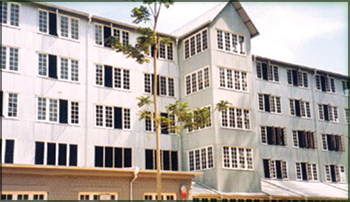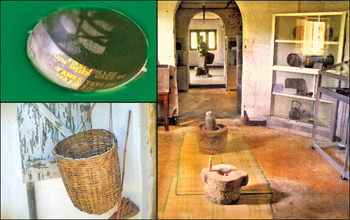Travel
Ceylon Tea Museum - Hantane
The proud monument to the success story of Ceylon
Tea:
Ganga ILLEPERUMA
The Museum , located in Hantane , Kandy has a fascinating collection
of age-old machinery , and the like. It traces the 130-years history
from the first tea plant brought to Sri Lanka by the Englishman, James
Tylor.
The Tea Museum,with an attractive wooden interior has a library too.
Today visitors can see the machinery as good as new and they could also
purchase some of the finest Ceylon teas that are in the market .The
oldest known existing packet of Ceylon tea, which is 56 years and still
in its original packing is also on display .
|

Ceylon Tea museum Hantane |
The Ceylon Tea Museum is open from Tuesday to Sunday from 8.15 a.m to
3.00 p.m. It is closed on Monday and Poya which falls on a weekday.
The recently opened Tea Museum occupies the 1925-vintage, four-story
Hanthana Tea Factory, 5km south of Kandy on the road to Hanthana. It is
served by a motor able road that circles the factory providing easy
access. Abandoned for over a decade, it was refurbished as a museum by
the Sri Lanka Tea Board in cooperation with the Planters' Association of
Ceylon.
In addition to displaying a good collection of 19th-century rollers,
dryers and other typical tea-factory equipment in their original
settings, the museum contains exhibits on the lives and work of Ceylon
tea pioneers James Taylor and Thomas Lipton.
Kandy is a mandatory stop on virtually every tourist itinerary, and
the location of Ceylon Tea Museum at Hantane makes sound economic sense.
It will also enhance the attraction of hill country to visitors.
Additionally its proximity to the Peradeniya Botanical Gardens, where
tea was grown commercially, make Hantane the perfect location. The
factory building consists of four floors. The ground accommodate heavy
machinery; the first floor is for Archives, library and the auditorium.
Second floor occupies some examples in the withering process. The fourth
floor is converted to serve a cup of tea.
"The Museum is established preserving the atmosphere of a tea
factory, at a cost of Rs. 32 million. The Museum project was carried out
by the Sri Lanka Tea Board, Tea Research Institute and the Planters'
Association of Ceylon" said Manager of Ceylon Tea Museum Hantane,
Dammasiri Madugalle.
|

Some of the iteneries on display at the Ceylon Tea Museum |
Built in 1925, the spacious four storied Hantane Tea Factory, had
been abandoned for more than a decade when it was earmarked for the
Museum Project undertaken by the Sri Lanka Tea Board and the Planters'
Association of Ceylon. Today it stands as a proud monument to the
success story that is Ceylon Tea.
Although exhibits are not abundant they do provide a valuable insight
into how tea was manufactured in the early days. Old machinery, some
dating back more than a century, has been lovingly restored to working
order. The first exhibit that greets visitors in the Engine Room on the
ground floor of the museum is the Ruston and Horns by developed diesel
and other liquid fuel engines, power for the estates were obtained by
water driven turbines.
Museum's "Rolling Room" offers a glimpse into the development of
manufacturing techniques with its fascinating collection of rollers.
Here the showpiece is the manually operated ' Little Giant Tea Roller'.
The Tree Of Life Hotel
Colonial times back to modern life:
The Tree Of Life Hotel in Kandy is one of the hotels in Sri Lanka
that has brought colonial times back to modern life. It is also one of
the most popular hotels in the region. Surrounded by 700 acres of tea
land, the Tree of Life has a rich history.
The old wing was an estate bungalow built during the colonial era
over 100 years ago in Sri Lanka. The Tree of Life has a unique
architectural design. A fusion of colonial style and an openness of
nature are put together in surroundings that are untouched by artificial
landscaping.
|

Entrance to the Tree Of Life Hotel |
A place where nature takes pride when surrounded by green carpets of
vegetation, with the Knuckles mountain range of place. Set in 64 acres
of idyllic uplands, the authentic draw of nature's tranquility is hard
to resist.
Luxurious Executive Villa is an addition to the Hotel Tree of Life
facilities with a large bed room and a sitting room with a spacious
bathroom with all amenities. Butler service to have your own meal
prepared for your choice in your private garden and parking facilities
near your room are some of the attractive features for the guest.
If you want to re-live the sound of music among green rolling hills,
tea plantations and nature that will simply take your breath away, visit
Kandy.
Among the many hotels in Kandy, the Tree Of Life Hotel will make your
visit successful.
The location of Tree Of Life makes your experience at the hotel even
more special. Located on lush greenery and tea plantations, the Tree Of
Life is only 15 minutes away from the city of Kandy.
The hotel amenities and services at Tree Of Life include delightful
rooms and suites for comfortable accommodation for guests. There are 40
accommodation units to fulfill your dreams of life amidst natural
surroundings.
The dining facilities at the hotel include restaurants that serve
delectable Sri Lanka cuisine and international fares to suit every kind
of taste bud.
The hotel amenities and services at Tree Of Life also include highly
professional business and conference facilities. Equipped with all
facilities for successful seminars and conferences, the Tree Of Life
Hotel is ideal for business tourists.
The location of Tree Of Life makes it a perfect escapade from the
stress of life and work. Free your mind and discover the essence of a
real vacation with a mountain top pool and breathtaking sceneries all
around you.
More than a hundred years old, the Tree Of Life Hotel has a beautiful
architectural design and reminds you of the glorious British days.
Marvel at the beautiful blend of nature and colonial architecture,
without any harm to the virginal beauty of the earth.
This nature resort is highly appreciated from the European community
for peace, harmony, quietness and unspoilt lush green land.
"We won the Green Glob certificates and a Presidential Environmental
award also. This hotel has very good collaboration with Japan and we
concentrate more on ayurveda promotion to Japan. We opened two ayurveda
centres in Japan called "Ayusha". We also opened the restaurant in Japan
called "Yalathanna" said Assistant General Manager, Timothy Paldano. GI
***********
History of Sri Lankan Tea
1824
A tea plant was brought to Ceylon by the British from China and was
planted in the Royal Botanical Gardens, Peradeniya. (non commercial)
1839
Establishment of the Ceylon Chamber of Commerce
1854
Establishment of the Planters' Association of Ceylon
1867
James Taylor planted the first 19 acres of tea in Loolecondra Estate
near Kandy, Ceylon and this marked the birth tea industry in Ceylon (Sri
Lanka)
1872
First sale of Loolecondra teas in Kandy
1873
Export of Sri Lanka's first tea consignment of 23 lbs from
Loolecondra Estate to London
1876
Founding of the first Broking firm John Brothers & Co.
1877
Manufacture of first "SIROCCO" tea drier by Samuel C. Davidson
1880
Manufacture of first tea rolling machine by John Walker & Co.
1883
The first public Colombo Auction was held at the premises of
Somerville & Co.on 30th July, 1883, under the auspices of Ceylon Chamber
of Commerce
1884
Construction of a Central Tea Factory on Fairy land Estate (Pedro) in
Nuwara-Eliya
1891
Ceylon Tea established a record price of £36.15 per lb at the London
Tea Auctions
1892
James Taylor, aged 57 years, died in Ceylon on 2nd May, 1892
1894
Formation of the Colombo Tea Traders' Association
1896
Colombo Brokers' Association was formed
1915
Mr. Thomas Amarasuriya, first Ceylonese to be appointed as Chairman
of the Planters' Association
1925
Establishment of Tea Research Institute
1927
Sri Lanka's tea production exceeded 100,000 metric tons.
Sri Lanka's tea exports exceeded 100,000 metric tons.
1932
Formation of The Ceylon Tea Propaganda Board.
Export of poor quality tea was prohibited.
1934
World's largest tea bush was found in Ceylon at Battawatta Group,
Madulsima.
It had a diameter of 24 feet and a circumference of 67 feet.
Four pounds of green leaf were plucked from it on one day
1935
Set up the International Tea Market Expansion Board (ITMEB) in which
Ceylon was a founder member
1938
The Tea Research Institute commenced work on vegitative propagation
at St. Coombs Estate, Talawakele
1940
Biological control of the leaf eating Tea Tortrix Caterpillar by the
Tea Research Institute
1941
First Ceylonese Tea Broking house, M/s Pieris & Abeywardena was
established
1944
Ceylon Estate Employers' Federation was established
1951
Export Duty on tea was introduced from 1st October, 1951
1955
First clonal tea fields came into bearing.
1958
Formation of the State Plantations Corporation
1959
Ad Valorem Tax was introduced on 1st June 1959 for teas sold at the
Colombo Auctions
1961
Sri Lanka's registered tea extent exceeded 200,000 hectares.
Sri Lanka's tea production exceeded 200,000 metric tons.
1962
Sri Lanka's tea exports exceeded 200,000 metric tons
1963
Production and exports of Instant Teas commenced
1965
Sri Lanka became the World's largest tea exporter for the first time
1966
First International Tea Convention was held to celebrate 100 years of
Tea Industry
1972
State take over of privately owned estates
1975
Nationalisation of Rupee and sterling companies
1976
Sri Lanka Tea Board was established.
Formation of Janatha Estate Development Board (JEDB).
Establishment of the Tea Small Holding Development Authority (TSHDA)
Exports of tea bags has commenced.
1980
Sri Lanka's partcipation at Moscow Olympics as official supplier of
tea
1981
Import of teas for blending and re-exports was introduced
1982
Production and Exports of Green tea commenced.
Sri Lanka's participation at 12th Commonwealth games at Brisbane as
official supplier of tea
1983
Centennial year of the Colombo Tea Auctions.
Production of CTC teas commenced in Sri Lanka.
1987
Sri Lanka's participation in 'Expo 88' as official supplierof tea in
Australia
1992
Sri Lanka completes 125 years in her Tea Industry.
An international convention was held in Colombo to mark the occation.
Formation of the Tea Research Board.
Abolition of the Export Duty on 21st December, 1992.
Abolition of the Ad Valorem Tax on 21st December, 1992.
1993
Privatisation of the management of Government owned tea estates
1996
Sri Lanka's tea production exceeded 250,000 metric tons
1997
Tea Exports reached 250,000 metric tons
2000
Tea production exceeded 300,000 metric tons
2001
Commencement of on-line sales of tea by Forbes & Walker Ltd., at the
Colombo Tea Auctions.
Establishment of a Tea Museum at Kandy.
2002
Tea Association of Sri Lanka was formed.
***********
|



